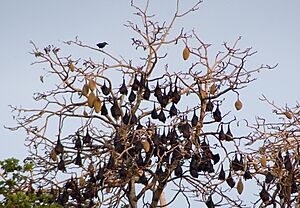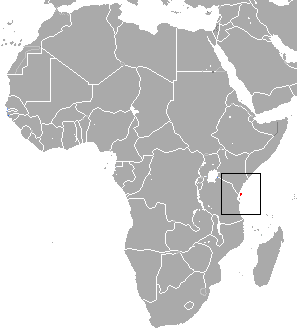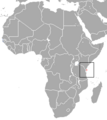Pemba flying fox facts for kids
Quick facts for kids Pemba flying fox |
|
|---|---|
 |
|
| Conservation status | |
| Scientific classification | |
| Genus: |
Pteropus
|
| Species: |
voeltzkowi
|
 |
|
| Pemba flying fox range | |
The Pemba flying fox (Pteropus voeltzkowi) is a special kind of flying fox. It is a type of bat that eats fruit. This amazing animal lives only on Pemba Island. Pemba is an island off the coast of Tanzania in Africa.
Contents
What Does the Pemba Flying Fox Look Like?
The Pemba flying fox is a very large bat. It has a wingspan of about 1.6 meters (that's over 5 feet!). This makes it one of the biggest fruit bats in the world.
It has a face that looks a bit like a fox. Its fur is a light brown color. The fur on its belly is orange. Its ears, nose, and wings are black.
An adult Pemba flying fox weighs between 400 and 650 grams. That's about the same as a small melon. Its body, from head to tail, is about 24 to 26.5 centimeters long.
Where Do Pemba Flying Foxes Live?
These bats live only on Pemba Island. This island is about 50 kilometers (31 miles) from the coast of Tanzania.
They like to sleep during the day in large trees. These trees can be in old forests or newer forests. They also live among mangrove trees. Sometimes, they even roost in old graveyards. People usually leave these places alone, so the bats are safe there.
A single roost, which is where they sleep, can have up to 850 bats!
What Do Pemba Flying Foxes Eat?
Pemba flying foxes sleep during the day. When the sun sets, they wake up and fly out to find food. They love to eat fruit. Some of their favorite fruits are figs, mangoes, and breadfruit.
They also eat leaves, flowers, pollen, and nectar. When they eat fruit, they swallow the seeds. Later, they drop these seeds in new places. This helps new trees grow all over the island.
Life Cycle and Young Bats
Young Pemba flying foxes are usually born between June and August. They stay with their mothers for several months. After that, they learn to find food and live on their own.
Why Are Pemba Flying Foxes Important?
These bats play a very important role on Pemba Island. By eating fruit and spreading seeds, they help the forests grow. This makes them like "gardeners" for the island's ecosystem.
How Are Pemba Flying Foxes Protected?
The Pemba flying fox is listed as a "Vulnerable" animal. This means they could be in danger of disappearing. For a long time, people hunted these bats for food. When shotguns were used, too many bats were hunted. Their forest homes were also being cut down.
In the early 1990s, there were only a few hundred of these bats left. But people on Pemba Island decided to help them. The Forestry Department started programs to protect them.
Here's what they did:
- They taught people about why the bats are important.
- They started wildlife clubs to protect the places where bats sleep.
- They kept track of how many bats there were.
- Hunting bats with shotguns is now against the rules in most places on the island.
Local people have been a big part of these efforts. Now, people can visit the island to see the bats. This is called ecotourism, and it helps the island earn money.
Because of these efforts, the number of Pemba flying foxes has grown a lot! By 2007, there were about 20,000 bats. By 2011, the number was close to 29,000. This shows that when people work together, they can help protect amazing animals.
Images for kids



